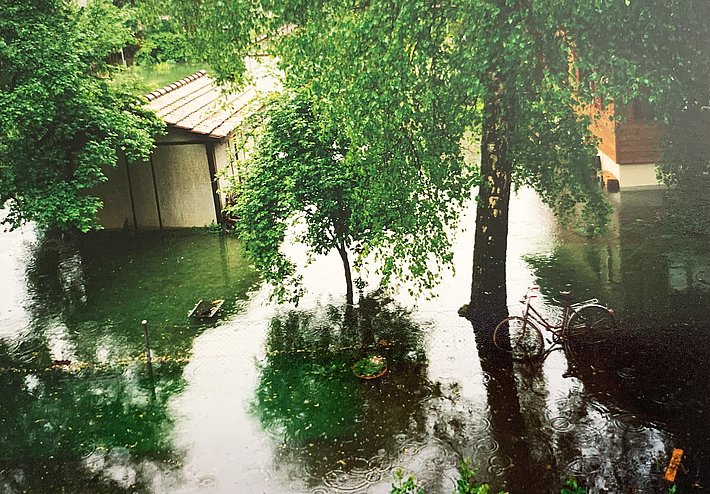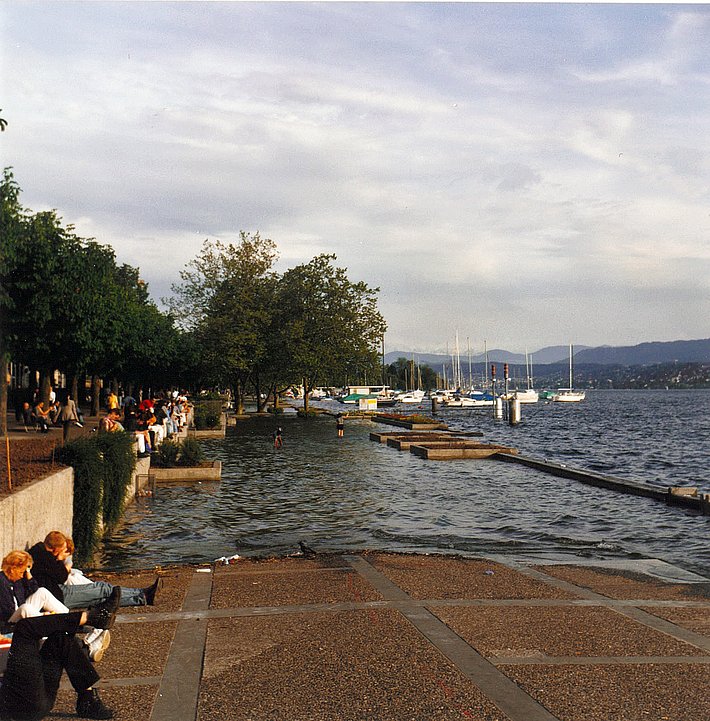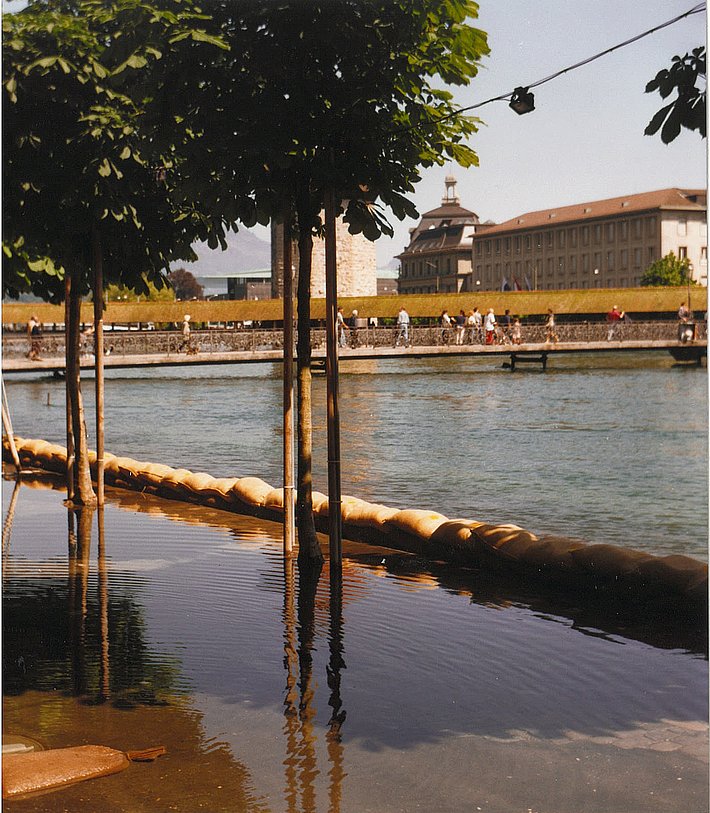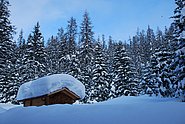The floods on Ascension Day and Whitsun 1999 remain among the most extensive and damaging spring floods in Switzerland. At the time, the Swiss Federal Institute for Forest, Snow and Landscape Research WSL analysed the events on behalf of the Confederation. Nowadays, the forecasts it issues together with federal offices help to limit the damage.
"In Thun, many people's homes were flooded on Ascension Day 1999," says Christoph Hegg, Acting Director of the WSL. "In the historic 'Matte' district of Berne, people were driving around in boats." At the peak of the Ascension Day flood, the left bank of Lake Thun was 400 metres further inland than usual, for several kilometres along the lake. Much of the canton of Zurich was under water. In Rheinfelden, the Rhine flooded the Zollvorplatz, shops, and cellars. In some villages on the shores of Lake Constance, houses close to the shore were under water for weeks.
Land under water in the Central Plateau ¶
May 1999 was a memorable month for many Swiss people: Switzerland experienced two major spring floods, the Ascension and Whitsun floods. They caused a total of CHF 580 million in damage, most of it in the canton of Berne, but the entire Central Plateau was affected.
WSL researcher Hegg, together with a colleague from the Federal Office for Water and Geology – now part of the Federal Office for the Environment FOEN – was responsible for reporting and analysing the events. What happened in 1999?
A "perfect storm" of rain and snowmelt ¶
Between January and the beginning of March, it snowed a lot, even in the lowlands. The high snow cover led to the numerous avalanches of the "avalanche winter"of 1998/99. Below one thousand metres, the snow thawed in March. In April, rainfall was above average, sometimes twice as much as usual. Towards the end of April, the snow also began to melt at high altitude. As the ground was already saturated with water, much of the meltwater flowed into the pre-Alpine lakes. At this point, they were still able to hold the water.
On 11 May, shortly before Ascension Day, it began to rain for days along the northern edge of the Alps. The centre of the precipitation was the Thur region. The volume of runoff water soon exceeded the capacity of the pre-Alpine lakes, which were already well filled with meltwater. They overflowed and flooded large parts of the settlement area. The rivers that carried water to and from the lakes also burst their banks. At Whitsun, on 21/22 May, it rained again. This time, it was heavy but shorter and centered on Lakes Uri and Walen. Once again, lakes and rivers burst their banks over large areas.
Limits revealed ¶
"The precipitation events on Ascension Day and Whitsun were different, but in both cases, it was the combination of water-saturated soils, snowmelt, and rainfall that led to the large-scale flooding," summarizes Hegg. "This showed that we need to take combined events into account, but most importantly it made us realise that the attenuation function of the lakes has limits." This, together with lessons learnt from other floods, led to various measures, such as hazard alarm systems by the cantons and the federal government, as well as the construction of the relief tunnel on Lake Thun and improvements in lake regulation.
"We also realised how important a good hydrological snow assessment is," says Manfred Stähli. The current head of the Mountain Hydrology and Mass Movements research unit was a researcher at the SLF at the time. "This event was a great motivation for us to systematically calculate the amount of snow water in the whole of Switzerland."
Today, the operational snow hydrology service at the SLF continuously analyses the snow situation in Switzerland and produces forecasts of how much meltwater and fresh snow can be expected in the short term (see interview) – information that would have been valuable in 1999.
Always up to date: Subscribe to the WSL Newsletter
Contacts ¶
Publications ¶
Bundesamt für Wasser und Geologie BWG, Eidgenössische Forschungsanstalt WSL, Birmensdorf (2000) Hochwasser 1999. Analyse der Ereignisse. (Studienbericht / Bundesamt für Wasser und Geologie). Bundesamt für Wasser und Geologie (Bundesamt für Wasser und Geologie BWG & Eidgenössische Forschungsanstalt Forschungsanstalt WSL, Eds.). 148 p. Institutional Repository DORA
Forster F., Hegg C. (2000) Die Hochwasser vom Mai 1999: eine Analyse anhand von hydrologischen Messungen in kleinen Einzugsgebieten. Schweiz. Z. Forstwes. 151(6), 183-191. https://doi.org/10.3188/szf.2000.0183 Institutional Repository DORA
Hegg C., Badoux A., Graf C., Röthlisberger G. (2000) Unwetterschäden in der Schweiz im Jahre 1999. Wasser Energ. Luft. 92(3-4), 59-68. Institutional Repository DORA
Copyright ¶
WSL and SLF provide image and sound material free of charge for use in the context of press contributions in connection with this media release. The transfer of this material to image, sound and/or video databases and the sale of the material by third parties are not permitted.










